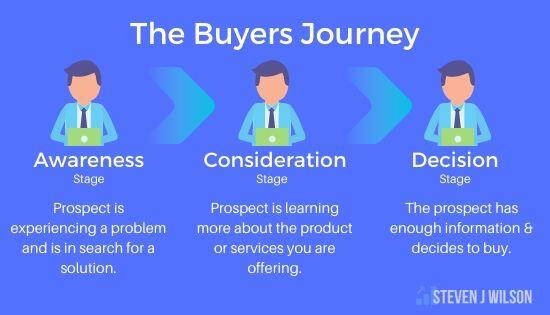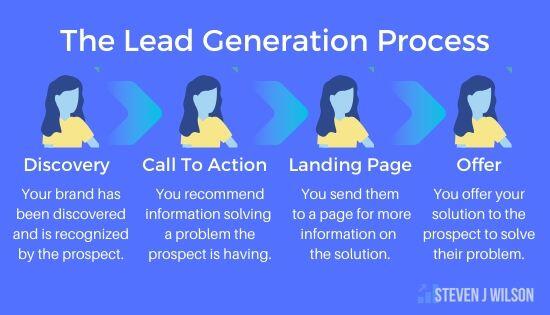In today’s developed market, lead generation becomes crucial for the survival of businesses, especially during this time. Your business can grow or become extinct based on how many leads you are able to generate.
Lead generation in digital marketing is about crafting valuable content for your audience & guiding them through a funnel that ultimately results in a sale.
To help you keep your head above the water and even thrive in today’s highly competitive business environment, I’ve put together a complete guide about lead generation. In this article, you will discover:
- What are leads
- What defines a high-quality lead
- How to generate high-quality leads
- Tips to increase the number of leads you get leveraging the power of digital marketing
By the end of this lead generation guide, you’ll be able to grasp the ins and outs of lead generation fully, and you’ll know how to get your own high-quality leads to keep your business flourishing despite any setbacks and challenges.
What is a Lead?
So what is a lead? A lead can be defined as a “prospective customer who lands on your page or gets into your marketing funnel and provides their contact information.” Simply put, a lead is a potential buyer who leaves their contact information and agrees for you to contact them, either by phone or email.

A site visitor can turn into a lead when they either register for an event on your site, call you, or contact you via live chat. If you have an upcoming webinar or a useful eBook, you can “gate” these assets and request for the email/phone number of your site visitors. Those who want to access these assets need to leave their name and contact information, turning them into a lead.
A site visitor who turns into a lead is eager to learn more about your products, services, or to find out valuable information that can help them. Even if most leads do not buy right from the start, as they are either in the awareness or the consideration stages, your chances of converting them into sales can grow considerably if you manage to “re-heat” your leads. I will detail the entire process later on.
The Importance of Generating Leads Today
According to a report by Nurture HQ, generating sales-ready, high-quality leads is one of the top priorities for modern digital marketers.
Smart marketers have understood that they need to employ the most innovative marketing techniques in order to turn today’s information-savvy users into leads.
Generating leads has become a must because of the digitization of our economy.
Almost all types of transactions are moving online. Banks are turning to digital onboarding, B2B companies are selling their services and products via their websites, and even realtors are using 3D mockups to sell houses and properties via the internet.
With more and more shoppers using the internet to purchase products and services, you need to have a strong presence online if you want to grow your business and outsmart your competitors.
Because most people tend to buy after multiple interactions, you need to have a proper attribution model in place. This means that you need to be aware of how much a particular technique in your funnel has contributed to the conversion.
Staying on top of the data you receive from every step in your funnel is vital to optimizing and scaling winning strategies.
What is a Good Quality Lead?
There are two types of leads – good quality leads, and poor quality leads. A poor quality lead is a person that will never buy from you or is not interested at all in what you have to offer. A good quality lead is someone who engages with you and has a real potential to turn into a customer.
Usually, most good quality leads are not necessarily ready to buy in the beginning. They need to realize that they have a desire and are the best person who can fulfill that desire.
As a rule of thumb, a good quality lead has the following traits:
They are pre-qualified: You have made an offer that only potential buyers of your product or service would be interested in, and they opted in to learn more. You need to send multiple emails and “feed” your leads various details, helping them to know, like, and trust you. This will help show them that they need you and should try your product/services.
They were quick to convert: A good lead that converts after just a few interactions is definitely a good-quality lead. So, even if they start to run dormant and don’t engage if you have a great product or service and delivering top quality, eventually, they could end up using your services again.
They are measurable: After the lead has made a purchase, you should be able to track that lead and discover more about there interest. For example, in the past, they have made repeat buys of a skincare product you sell but have recently liked one of your social media posts on skincare tips. This data is priceless and can be used to send special offers on skincare products to help re-heat a previous customer.
The Lead Generation Process
The lead generation process is pretty simple and straightforward. Let’s break it down below:
Step 1: A prospect discovers your brand through a marketing channel or tactic, such as paid ads, organic, email marketing, video marketing, or social media.
Step 2: The prospect clicks on a call-to-action, or CTA, which can be a button, message, video, or photo, which takes them to a landing page to learn more.
Step 3: On the landing page, the prospect finds an asset that they want to download, or wishes to talk to you via chat. They fill out a form in exchange for an offer.
Step 4: You are sending your leads emails to nurture them and to encourage them to choose you as their vendor or provider ultimately.

Let’s take a closer look at each of these steps:
1. Discovery
The first and most crucial step in this process is the discovery phase. You can use a wide variety of channels to promote your landing page and to showcase your brand’s strengths. You can choose anything from content syndication, blog posts, social media posts, emails, ads, retargeting campaigns, product trials, referral marketing, affiliate marketing, or even search engine optimization (SEO) for organic traffic.
Of course, another option you have here is to buy leads, but that’s not the ideal scenario for numerous reasons.
First, the leads you’ve purchased do not know you and have not found you online. If someone receives an email from a company that they never encountered online or spoken with, they will more than likely neglect your messages.
Second, you might be flagged as a spammer, and your account might suffer from that.
Third, you might buy a faulty list that has very few good potential leads. You would have done much better by investing in content syndication, native advertising, or remarketing.
To be safe, always try to generate leads organically.
2. CTA
The CTA is a key component of your lead generation process. Once your business is discovered on the targeted digital channels, you want to ensure that your CTA sparks the interest of your prospects and that they click on it. If your CTAs fail to capture the attention of your audience, then all your efforts, time, and money spent would have amounted to nothing.
To create a killer CTA, here are some advanced rules you can use:
- Always use a strong command verb at the beginning: verbs like “shop,” “order,” “discover,” “find out how,” or similar ones will help boost your engagement rate quite a lot.
- Make use of words that provoke enthusiasm and spark emotion: examples include “plan your dream vacation right now” or “buy it now and get a whopping 80% off”.
- Offer your audience a compelling reason to act: think of your audience when creating the CTA. What’s in it for them if they click and land on your page? Tie the reason with your unique selling proposition (USP).
- Leverage FOMO: also known as the Fear of Missing Out, this is a motivating factor that can dramatically increase engagement rates on your CTA. The best way to capitalize on FOMO is to mention a limited promotion. For instance, you can say something like this: “Limited offer! Sale ends today!” or “Download the eBook until it expires.”
- Get creative: a killer CTA is always the result of creativity. For example, instead of a bland message that everyone uses like: “Call us today for more information,” use “Don’t miss out! We’re just a phone away!”. Also, the standard “Check out today’s deals” could be transformed into “Tons of amazing deals at your fingertips” for improved conversion rates.
Never get married to what you like or think your audience will like. You have to pay attention to the data. You may have to test several variations of your CTA to find the one that converts the best.
3. Landing Page
Once a user clicks the CTA in an ad or organic message and lands on your page, it is time to start the education process. While your final goal should be to convince your site visitors to leave their details or to contact you for a personalized deal, you must also focus on providing useful information to your users.
Educating your visitors before trying to convert them is key to gain more good quality leads. For example, if a user enters your page after he saw an ad about the new GDPR regulations, he will want to find out more about this and about how GDPR can impact his Europe-based store or clients.
After offering helpful information, you can provide them with an offer to leave their contact information in order to gain access to an outstanding GDPR-information eBook that can solve their problem. Anyone interested will leave their details, and you’ll have a new lead in your funnel to begin the nurturing process.
Your page and your lead capture forms should be eye-catchy and should entice your site visitors to interact with them.
4. Offer
In exchange for their personal information, you can give your site visitors an exceptional piece of content. This can be a whitepaper, case study, infographic, webinar, how-to video, interview, template, data visualization, free trial, a demo video, spec sheet, coupon, or quote.
How do you Generate Quality Leads?
When it comes to lead generation, it is crucial that you generate high-quality leads. Failure to do so can result in over 67% loss in sales, according to Steven Tulman.
To generate quality leads, you need to look at several aspects.
First, try to find out if your prospects have a specific need that they want to solve.
Second, provide a unique solution that caters to their needs and is easy to implement.
Next, do some brainstorming and research to discover if your target audience has enough money to spend on your solution.
The fourth step of the process involves taking into account the level of influence your prospects have in making a decision. If they are not the final decision-makers, you should probably get more targeted and focus on bringing only decision-makers on your site.
Lastly, think of how soon your prospects need to implement a solution.
To generate good quality leads, you need to add value through everything you do. You want to establish yourself as an expert in your niche who knows how to solve specific problems your customers might have. Your content should also be focused on addressing your customers’ pain points.
In the awareness stage, you should only create content that focuses solely on solving the user’s problems and needs. Next down the funnel, you should show them how your company can quickly solve their problems.
Only after they have decided to see what you have to offer, you can start promoting your services and advertising your expertise and accomplishments.
How do you Get Leads in Digital Marketing?
Today, marketers are more focused on the quality of leads than on quantity. For that, they use a mix of inbound and outbound lead generation methods. To get good quality leads you can focus your efforts on several areas:
Outbound lead generation strategies
These include content syndication, display ads, PPC ads, event marketing, and retargeting. Also known as “interruption lead generation,” these strategies are perfect for reaching out to prospects in the awareness stage who are not yet aware of your services.
The most common outbound lead generation strategy is using content syndication. This tactic involves pushing out your content on third-party sites to create awareness and spike interest. By wiring your content into specific digital contexts related to your business, you can boost your reputation and drive highly-qualified leads over to you.
Inbound lead generation strategies
Social media marketing, SEO, content marketing, email marketing, and website optimization are considered inbound lead generation strategies. This is a tactic that leverages your prospects’ desire to make a purchase and showcases yourself as a true and tested solution. By offering an interesting mix of content and assets, you can spike your customers’ visitors and drive them down the funnel to the purchase stage.
A Website
Optimizing your website is key to getting more qualified leads. This is probably the most essential method of generating high-quality leads since your website acts as a portal between your brand and potential customers. Almost all customers convert after at least one interaction with your website or landing pages, so you want to ensure that your main platforms offer a superior experience to all its visitors.
Since over 96% of visitors who land on your site are not yet ready to buy from you, it becomes crucial to optimizing your website. This means you need to ensure it loads extremely quickly, it works flawlessly on mobile devices, offers streamlined navigation, and has no broken links.
A Blog
Your blog content is an excellent source of new leads, especially when it is optimized for search engines. You can use a wide range of methods to transform your blog into a lead-generation system.
For starters, you want to offer exclusive content to your readers that provides value and demonstrate your expertise.
Next, you can offer them certain perks. For example, if they read your blog on a regular basis, you can entice them to enter a contest and win a discounted product or service.
Lastly, try to capitalize on slide-in CTAs that appear on the page once readers scroll down the page. Intrusive popups still work, but I’m a fan of less intrusive options as long as they convert better, of course.
Content + SEO
Your content all across your site should be optimized for SEO. Of course, SEO is quite complicated and involves optimizing numerous aspects on your website, together with link building and social media integration. However, the most crucial part of SEO involves creating content that sparks engagement and uses the right keywords.
To generate leads through SEO, you should also start using schema markup. Schema markup enables you to rank higher in SERPs (Search engine result pages) by enabling search engines to understand your content better. This may also allow you to get featured in Position 0, which will drive up additional targeted traffic to your site.
Email marketing
An essential lead generation method that comes at a reduced cost and offers excellent results is email marketing. This is widely considered to be the least costly ways to generate high-quality leads and to re-heat cold leads. Email marketing is famous for enabling US-based businesses to enjoy up to a 4,300% increase in ROI.
To fully capitalize on the power of email marketing, you should start by designing automation campaigns and a funnel. People who land on your page from any source and complete the form should immediately receive a thank you email, plus a link to the resource they requested. After a few days, they should receive a follow-up email with a link to another asset. This funnel can have several iterations, driving people down the funnel until they are ready to purchase from you.
Social media
Leveraging the power of social media is a must if you want to get more leads. To use social media marketing for lead generation, you can start by promoting gated content on your social media accounts. Next, use giveaways and contests and drive up engagement. Lastly, set up alerts for relevant keywords or hashtags that mention your brand or your products. You can also use a tool such as Hootsuite to stay in control of your social media management.
Ads
PPC Ads represent a unique online advertising model where you can display information about your products and services. You’ll pay when a user clicks your ad and visits the page, or you can pay for 1,000 impressions. You can run PPC ads on virtually any platform, including Google Search & Display Network, Facebook, LinkedIn, Quora, Twitter, and even Amazon. You can create highly targeted display options in order to reach your prospects right where they are. With this method, you can generate new leads extremely quickly. However, it is imperative to continue “heating” them on your site and email list, with targeted content.
Final Thoughts
In conclusion, it is vital to strive to leverage all the tools and strategies you have at your disposal in order to drive more qualified leads.
People can quickly find any type of information they want without much effort. This can hinder your growth if you don’t have enough content or the proper lead generation methods in place.
The ever-increasing competition has made it a must to implement effective digital marketing strategies in order to compete in many industries.
If you need help integrating a new tactic that would help you drive more quality leads, do not hesitate to contact me.
What are some lead generation tactics that work well for your business or areas you’d like to improve on?





